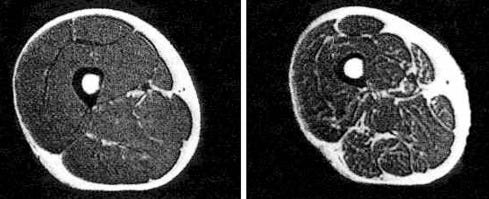Your New Year's Resolution should be to build more muscle
And how to do it efficiently
Sarcopenia is bad:
If you’re anything like most of my patients, I suspect the gif below captures your response to this newsletter title:
When I suggest to my patients that they should be lifting weights to build muscle, many of them think I’m nuts and immediately tune out the rest of my non-pharmacologic advice. After all, very few people come to the cardiologist because they want exercise advice.
But I think this is really important, and I’m writing about this is because of the disconnect between how important I think it is and the [lack of] emphasis that’s placed on this in the world of medicine.
Truthfully, perhaps the single most common thing that people I see (both in my clinical practice and in my regular life) could do to increase the quality of their life is to build more muscle.
Let me try to persuade you why this matters before giving my advice on how to do it in the simplest way possible.
Preventing sarcopenia starts early
Sarcopenia is a generalized term for loss of muscle mass. It can happen for a variety of reasons, but it’s super common to see in older people who aren’t exercising specifically to avoid it.
Take a look at these legs - the one on the left is from a 25 year old, the one on the right is from a 65 year old:

The circumference is pretty similar, but the muscle mass is not. If you aren’t working to build muscle, your muscle gradually shrinks and becomes infiltrated by fat. Your fat mass increases and takes over.
This process starts way younger than you’d like to think.
If you’re in your mid 30s and you don’t do strength training regularly, you know why your arms and legs don’t look any smaller than they did when you were 25 despite the fact that they’re much weaker?
It’s because they’re starting to get filled with fat instead of muscle.
If you become sarcopenic, your risk of developing life-limiting frailty increases
Frailty is one of the biggest problems of aging and one of the greatest challenges in geriatric medicine.
Frail patients die earlier, have a lower quality of life, and generally tolerate aging much more poorly than people who aren’t frail.
But it’s silly to think that frailty waits until you’re 80 to start happening. What you do now influences how you’re going to age.
Not being frail is the difference between being someone who falls and gets right up unscathed versus someone who either breaks a hip or can’t move right for days after slipping on the ice.
Building muscle and getting stronger prevents frailty.
The best time to start building muscle is today, because every day that you wait it just gets harder to do.
Muscle improves insulin sensitivity and reduces metabolic syndrome risk
The more muscle you have, the lower your risk of metabolic syndrome.
I am fully persuaded that a large part of age related metabolic syndrome risk is driven by loss of muscle mass.
I’ve written a lot before in this newsletter about insulin resistance and metabolic syndrome, which are underlying problems in most chronic disease.
Insulin resistance increases the risk of heart disease, cancer, and Alzheimer’s. A lot of high blood pressure is caused by insulin resistance. Diabetes is the end stage of insulin resistance where you can no longer make enough insulin to lower your blood sugar.
And the evidence is pretty clear that more muscle means less insulin resistance and less metabolic syndrome.
A huge part of this impact is related to how our muscle mass influences energy metabolism and nutrient partitioning (whether the things that you eat go into your muscle or into your fat cells).
Exercise and building muscle works through a number of different biologic pathways to lower your blood sugar, improve sensitivity to insulin, reduce insulin levels, and perhaps even positively impact your cholesterol levels.
Muscle is an insurance policy in case you get sick
Let’s say you get a bad case of the flu (or COVID) and you’re hospitalized for a couple of weeks. What do you think happens to your strength. What happens to your ability to take care of your activities of daily life - carrying groceries, picking up kids/grandkids, getting up the stairs?
The answer is that you lose your strength pretty quickly and the older you are, the longer it takes to build it back up.
If you’ve built additional muscle through strength training before you get sick, you have a bigger buffer against the loss function that can happen during an illness.
Muscle is more important than long term care insurance and working more hours to make more money can’t make up for not having it:
How to build muscle
You can make this into the most complicated topic in the world, but it doesn’t have to be. It also doesn’t have to be time consuming.
If you spend 15 minutes twice a week doing this, you’ll make progress as long as you create progressive overload.
It’s actually pretty straightforward for most people because there’s a lot of low hanging fruit. Here’s my advice. You’ll need a paper and pen or a smart phone with a notes app:
Pick one exercise for each of the 7 major muscle movements (see below)
Do one (1) warmup of each exercise with an easy resistance or weight. Wait 90 seconds after your warmup to do the work set:
Do one (1) work set of 8-15 repetitions. Do as many as you can. If you get to 15, you increase the weight for the next workout.
Write down what weight you used and how many reps you did. Remember, if you got to 15 repetitions, it means that you increase the weight for the next workout.
The 7 major movements are things you’ve heard about before:
Lower body hip dominant - hip thrust or deadlift
Horizontal push - chest press
Horizontal pull - row
Vertical push - shoulder press
And that’s honestly it.
For 99% of people, this will be adequate to prevent sarcopenia, avoid frailty, and improve metabolic health.
If you don’t feel comfortable with the form, watch a couple of YouTube videos. Start light. Or just get a trainer to teach you the motions.
The most important part is to keep track of what you’re doing and increase the number of repetitions and the weight as detailed above.
I wouldn’t be spending time writing about this if I didn’t think it was important - and if reading this makes you feel out of your comfort zone, it probably means you need to hear this information even more.
Thank you for reading! Please share on social media and encourage your friends and family to subscribe!



